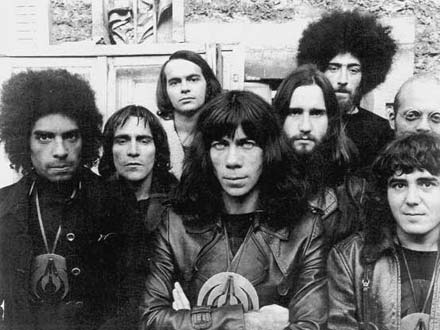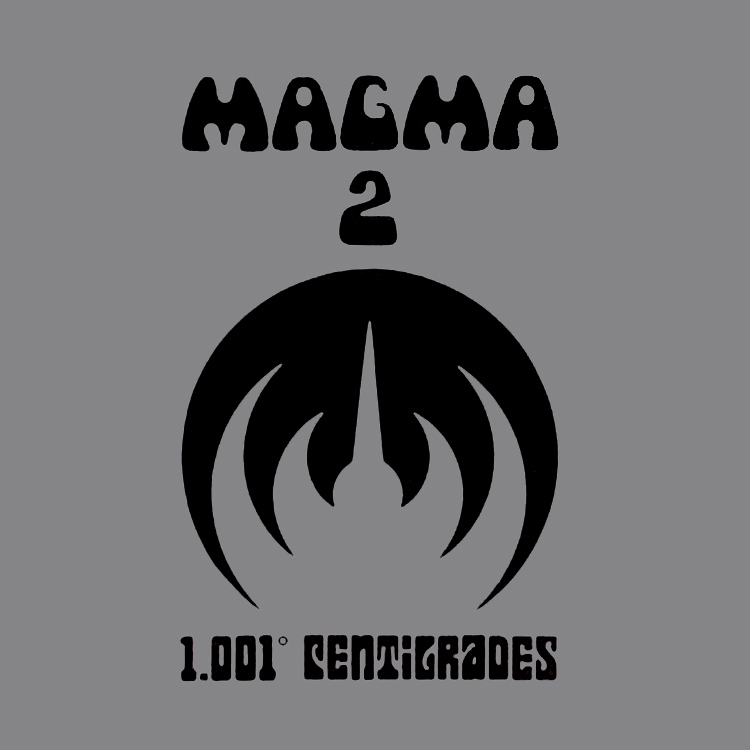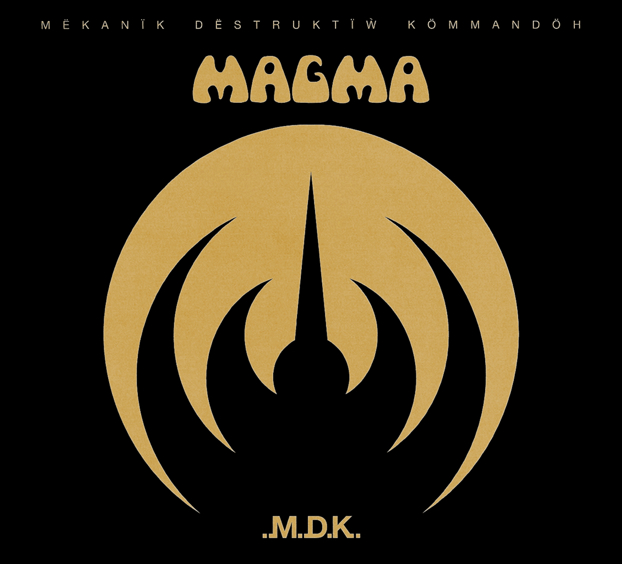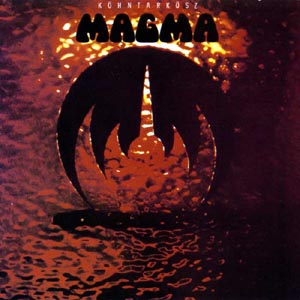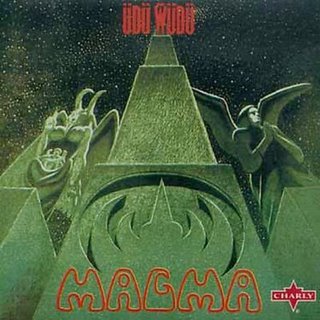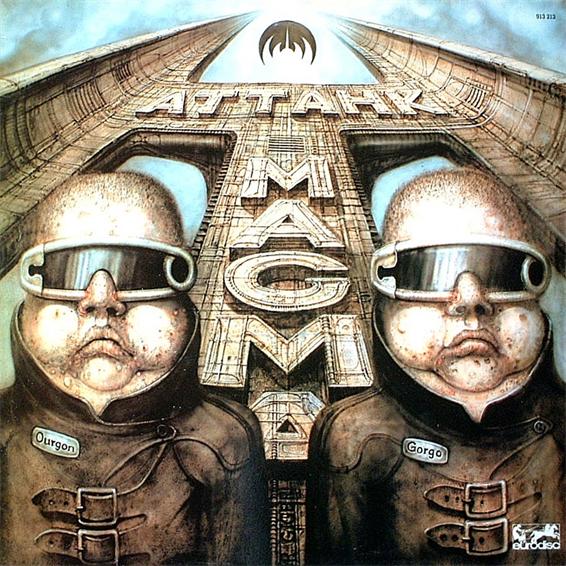Originally written for Prog Zone Magazine in April 2013.
While many progressive rock bands owe a debt to the classical and jazz music that came before, few were as successful at combining both styles simultaneously as the French band Magma. Their unique sound arose from the brain of drummer, vocalist and main composer Christian Vander in response to the death of jazz saxophonist John Coltrane. Coltrane’s themes of spirituality and transcendence (most obvious in his later albums A Love Supreme, Ascension and Meditations) persist throughout all of Magma’s works, even as their sound changed to further incorporate classical and operatic influences – those of Carl Orff in particular. Vander unified these influences with an ambitious sci-fi concept that lead to the most controversial aspect of Magma’s sound. All the albums (excluding a one-off flop in the 80s) are sung in Vander’s invented language: Kobaïan.
Here’s where things start to get really interesting or really absurd, depending on who you’re talking to. Magma’s first few albums explore the changing relationship between Earth and the fictional planet Kobaïa, sung from the perspective of the Kobaïans. Later efforts explore other Kobaïan stories and in some instances even delve into Egyptian mythology, though all are still sung in this fictional language. The tales of peace, conflict and spiritual enlightenment were often told in movements over multiple albums, and generally recorded out of order. For example, the Theusz Hamtaahk song cycle was fully written in the mid-70s, with the third movement released in 1973, the second in 1974 and the first in 1981! Talk about confusing. But also, talk about dedication to the song cycle. I get the distinct feeling that in the mid-70s, whilst otherwise being drowned in pop, funk and soul music, Richard Wagner held a massive erection for this band. Yes, while in his grave.
The language itself has a very Germanic feel, thanks to the extensive use of umlauts and harsh consonants, but the vocal delivery is entirely unique. An array of vocalists contribute to the operatic cacophony of Magma, including Klaus Basquiz, Christian Vander himself and wife Stella, rarely dropping below a falsetto and always in danger of shattering nearby glassware. Over the years, these intensely high vocals became more and more the focus of the music, culminating in 1973’s epic Mëkanïk Dëstruktïẁ Kömmandöh. If someone calls Tommy or The Wall a rock opera, you have license to laugh in their face and direct them to MDK; the only album I’ve heard which truly owns that title.
Some may find Magma’s Kobaïan mythos and vocal delivery off-putting, but the result is profound. The combination of Coltrane’s jazz and thematic influences with operatic vocals and Magma’s own rock sensibility meld to create a sound Vander described as ‘zeuhl’, Kobaïan for ‘celestial’. This sound – bottom heavy with grooving bass and drums but transcendent with horns and vocals – would influence both Magma’s contemporaries and bands to come. Magma would become a centrepiece for the Rock In Opposition movement, headed by similarly avant-garde bands such as Univers Zero, Henry Cow and Art Zoyd, continuing to play at the RIO festival in France even in recent years. Many newer bands also carry the zeuhl torch – Ruins and Koenjihyakkei, Guapo, Bondage Fruit and even Magma alumni Jannick Top – but to this day no-one fully sounds like Magma.
The music perfectly carries the magnitude of the Kobaïan story and Coltrane’s spirituality even when the vocals are indecipherable and, as silly as you may find the original intent to be, delivers with such a beautiful sincerity it’s hard not to be won over.
Below I look at the highlights of Magma’s career, following their journey from jazz-rock to opera to something else entirely.
Jazz Magma
1971 – 1001⁰ Centigrades
Magma’s second album tells the story of Kobaïans visiting Earth for the first time – again, all sung in Vander’s invented language. At first, there is a cultural renaissance as the two peoples exchange thoughts and ideas. But it isn’t before long before the Kobaïans are imprisoned (typical Earthlings!) and a rescue mission is organised. Kobaïa orders that either the prisoners be released or Earth meets total destruction. Earth agrees (typical Earthlings!).
Pretty nerdy stuff, right? Right. But this gives Magma the license to explore the shifting dynamics of peace, conflict and tense resolution through their complex compositions. The first track, ‘Rïah Sahïltaahk’, is one of Magma’s best compositions and their first true epic. The progression from excitement and joy to betrayal to intense anger and then resolution is easily followed, but more importantly the music is just awesome. A 22 minute foray into jazz fusion featuring impossibly high warbling falsettos, ever-shifting time signatures and unexpected changes in structure, the ambitiousness of the piece and skill of the musicians cannot be understated. The other two tracks are enjoyable enough and certainly have great moments, but just can’t compare with what comes before.
The complex and exultant horn and piano lines grounded by the powerful rhythm section perfectly encapsulate the otherworldly, ‘celestial’ feel that Magma is now so well known for. As such, it’s a shame that this line-up would disband shortly after creating such a work; Vander was becoming more and more interested in exploring classical influences, whilst other members preferred the jazzier approach. This lead to the departure of Jeff Soffer (sax/bass clarinet) and Franҫois Cohen, (piano) who then formed the band Zao. Luckily, Zao is the logical progression of jazzy Magma and is highly recommended if you’re yearning for more in this vein. Magma, however, were onto bigger and better things.
Classical Magma
1973 – Mëkanïk Dëstruktïẁ Kömmandöh
From the moment a choir of male and female operatic vocals appear behind booming apocalyptic horns at the beginning of “Hortz Fur Dëhn Stekëhn West”, it is clear this is a new Magma. Never before have they sounded this epic, this intense.
Magma’s magnum opus (called MDK for short) is an operatic tour-de-force, a continuous 39 minute piece that is a drastic departure from their previous work. Focusing on driving, pulsating rhythms and introducing further (female) vocals to the mix, everything sounds far grander than before. Everything is done to extremes. The rolling pulse of the piano and drums that persists throughout the piece adds a visceral urgency. Horns blare, the piano interchanges between tinkling and ham-fisted mashing and the choral vocals whisper and shriek. Add to that funky bass lines (courtesy of the excellent Jannick Top), an occasional gospel influence and so, so many polyrhythms, one feels on the verge of being overwhelmed by the enormity of the enterprise. But it never becomes too much, so all you can do is listen in awe as all this happens around you.
Utterly captivating and unique, MDK is unquestionably Magma’s finest hour. Their next release Ẁurdah Ïtah (although technically released under the guise of a Christian Vander solo album) is the second movement in Theusz Hamtaahk – that is, we’ve gone backwards. The problem is, it feels like that too. Released as a soundtrack, the music is understandably less intense and the lineup is shrunk to just a quartet (13 people are credited on MDK). As such, the album sounds lacking. Where MDK embraces its classical roots and symphonic sound completely, Ẁurdah Ïtah comes across as underdeveloped. Unsurprisingly then, Magma head in quite the different direction with their following album Köhntarkösz.
Zeuhl Freed From Its Shackles
1974 – Köhntarkösz
Although the 30 minute title track begins with the same explosive bombast as MDK, Köhntarkösz is an entirely different beast. The second movement in yet another three-part song cycle, it crawls towards its goal; the simmering tension always rising but never boiling over. Gone are the horns that have defined Magma in the past. The focus now shifts to ominous bass lines and shimmering keys in a sea of slow polyrhythms.
Although often overshadowed by MDK, it is the menacing sound of Köhntarkösz that has seemed to live on in later zeuhl bands – Shub Niggurath’s 1989 album Les Morts Vont Vite instantly springs to mind. Whereas previous albums always had an uplifting feel in spite of their intensity, Köhntarkösz submerges the listener in dark grooves and offers few chances to breathe. The sparse vocals on the album add to the eerie atmosphere, but also provide a nice way for first-time listeners to get into Magma without confronting those ear-shattering falsettos head-on.
Köhntarkösz is also the moment where Magma finally rid themselves of the constant comparisons to Carl Orff and John Coltrane. The latter may be given a nod in ‘Coltrane Sündia’ (Coltrane Rest In Peace), but this is a whole new sound. A defining moment for this ever-changing band.
Delicious Bass Times
1976 – Üdü Ẁüdü
De Futura. Enough said.
Seriously. Virtuoso bassist Jannick Top composes several tracks on this album, but nothing compares to his evil grooving epic. A 17 minute mass of intricate bass lines, distorted guitar (a rarity for Magma) and the pounding of Christian Vander’s militant drums, De Futura opens the valve for the tension that built throughout Köhntarkösz. This track quickly became a staple in their live repertoire and a fan favourite, whilst the rest of the album acts as a brief overview of Magma’s entire career. The cheerful vocals and jazzy horns of the title track bring back memories of 1001⁰ Centigrades, whilst in other places the epic choirs of MDK mix with the brooding bass lines of Köhntarkösz. This jumping around means the album lacks the cohesion of previous efforts and there are signs of the band running out of ideas.
After Üdü Ẁüdü, keyboardist Patrick Gauthier and vocalist/bassist Bernand Paganotti would leave to form another zeuhl band Weidorje (another band worth checking out), named after the track on this album. Although they had created one of their best pieces of music, Magma was struggling and the lack of success of this album and their live album Inédits lead to the group disbanding. For two years. In 1978, they returned with a different lineup and yet another different take on the genre they created.
Magma Sell Out?
1978 – Attahk
Attahk distances itself from the conceptual themes of the Magma from the past, with some titles even being written in English (gasp! Blasphemy!). Steeped in funk, gospel music and jazz fusion, Attahk dismisses Magma’s classical side almost entirely in favour of undeniably catchy grooves. This shift lead to a backlash from hardcore fans who believed they were listening to Magma sell out. However, those love-them-or-hate-them falsetto vocals were still a big focus and the music remained undeniably complex, which meant they didn’t gain a new pop audience either. Ouch. The result is Magma’s most underrated album, and even one of their best (provided fusion is your thing). ‘The Last Seven Minutes’ perfectly encapsulates its title; with vocals like James Brown on crack and fiery bass leaping around like it really is the end of the world. Elsewhere, ‘Spiritual’ and ‘Liriïk Necronomicus Kahnt’ dance with the transcendent beauty that only Magma can make, through gospel music and jazz-rock respectively. There is the odd cheesy moment, but overall Magma changed their sound successfully yet again. It’s just a shame at the time few were willing to listen to it. After this, Magma wouldn’t make another album for 6 years. And not another good one for 26.
Where Are They Now?
After a universally condemned flop in 1984, Christian Vander disbanded Magma (again) to focus on the much jazzier solo project Offering. But there was clearly a yearning to complete those incomplete song-cycles, and in the 2000s Vander returned to the Köhntarkösz cycle he had written back in 1973-74. K.A.(Köhntarkösz Anteria) was released in 2004 and Ëmëhntëhtt-Ré in 2009, both albums critically praised for continuing with the dark, brooding intensity Köhntarkösz was known for.
They may have had their ups and downs, but Magma have returned in full force by embracing what made them great in the first place. Unifying jazz, funk, gospel, rock and classical music seamlessly with the most dedicated career-long concept I have ever heard of, it is a credit to the ambition of Christian Vander and fellow musicians that Magma persisted through to 1978, let alone the present day. I can only imagine the ridicule you would get pitching the Kobaïan concept to a record label now. I can’t even imagine it going well back then. But if you are willing to suspend disbelief – to look out at the sky and imagine Kobaïa – what lies within the music of Magma is something special known to few people. Call it spiritual, call it transcendent, call it zeuhl, call it crazy-cool-funky-prog-falsetto-music – whatever its name, Magma have created something entirely their own. Or, as they would put it, Zeuhl Iss De Hündïn!
Having trouble finding Magma albums? Welcome to my world. The Seventh Records site hosts all their albums, although some are pretty pricey. Check out 2012’s Félicité Thösz, or the awesome reissue titled ‘Trilogy’, which bundles together Üdü Ẁüdü, Attahk the 1975 live album Live.
